OSU at Marion
June 12, 2008
Not exactly a popular tree, Ailanthus altissima (tree-of-heaven, family Simaroubaceae) is a very fast growing weed of roadsides, open woods and edges of woods. It’s flowering now. Big whoop.
tree of heaven flowering
Tree-of-heaven (Ailanthis altissima), June 12, 2008, OSU at Marion.
The breeding system of this plant is described as “polygamous” defined as bearing partly perfect, and partly unisexual flowers. Last year as part of the “tree flowers” project, I tried to photograph this species at a location in Columbus where, as luck would have it, all the trees were staminate (male)! This time and place, however, the plants are more cooperative, bearing what looks like perfect (bisexual) flowers. Here’s a closeup.
Ailanthus flower
Ailanthus altissima flower, June 12, 2008, Marion County, OH.
But how on earth will flowers like these –having a deeply 5-parted ovary –develop into fruits like the ones shown below (taken at the same locality late least year). Tree-of-heaven produces winged one-seeded fruits, called samaras, as do ash, maple, elm, and tulip-tree. It doesn’t seem possible. We’ll have to wait and see!
Ailanthus fruits
Alanthus (tree-of-heaven) fruits, OSU at Marion, October 17, 2007.
Catchfly, and an Uncaught Fly
Caledonia, Marion County, OH.
June 12, 2008
Caledonia Woods is a 32.8 acre lowland forest owned and managed as a nature preserve by the Marion County Prairie Parks Commission. It is bordered by the Olentangy (Whetstone) River. An active set of RR tracks runs through it. There is a small barren area that was once used as a disposal site for dredge spoils. It is occupied by alien weeds and native early succession pioneer trees. One of the weeds is a delicate member of the pink family (Caryophyllaceae) called “night-flowering catchfly” (Silene noctiflora). It is presently in fruit, not flower. The fruit is a capsule that opens by teeth (suggestive of a moss capsule).
catchfly fruits
Night-flowering catchfly (Silene noctiflora) fruits, Caledonia, OH, June 12, 2008.
The reason for the odd name is that the stem has sticky parts along its length. In a couple of places about an inch long, it’s tacky like flypaper. This seems more likely to be an adaptation to discourage ants rather than flies, since ants are more likey to try and crawl up stems than are flies. Flies fly.
catchfly stem
Night-flowering catchfly (Silene noctiflora) stem, June 12, 2008, Caledonia, Ohio.
Nearby, field bindweed, Convolvulus arvensis (family Convolvulaceae) is merrily being visited by a syrphid fly. These look like little bees, but they’re flies. Flies are easy to recognize if you can get close enough. They have only one pair of wings, the front pair. The hind wing are modified into little knob-like balancing organs called “halteres.”
field bindweed
Field bindweed (Convolvulus arvensis) being visited by a syrphid fly.
Caledonia, Marion County, OH, June 12, 2008.
Does the syrphid fly pollinate the bindweed? It isn’t apparent from this observation. The fly certainly grabbed on to the pollen-receptive stigma, as shown in this “actual pixels” blow-up from the photo above. But there doesn’t seem to be any pollen accumulated on the fly’s body that could transfer to the stigmas.
fly on styles of bindween
Syrphid fly grasping stigmas of bindweed, Caledonia, Marion County, OH, June 12, 2008.
It’s also hard to see exactly what the fly is getting from the flower. Some flies, including houseflies and apparently this one, have “sponging-sucking” mouthparts, shown below in an enlargement of another picture. We can see it is trained on the pollen-bearing anther. Does this fly ingest pollen? It doesn’t seem possible with this type of feeding apparatus. But what other nutrition is there for the fly to suck up?
sponging-sucking activity
Syrphid fly sponging-sucking who knows what from bindweed anthers,
Caledonia, Marion County, OH, June 12, 2008
Arghhh! Hemlock!
Columbus OH Roadside
June 7, 2008
Many central Ohio roads are now flanked by a dense monoculture of our most poisonous poisonous plant, poison hemlock, Conium maculatum. (Danger, poison!)
hamlock along road
Poison hemlock (Conium maculatum) along Columbus roadside, June 7, 2007.
This stuff is really toxic. The active ingedient, Conine, is a neurotoxin that blocks an acetylcholine receptor on the neuromuscular junctions of peripheral nerves, causing an ascending muscular paralysis that eventually stills the muscles that enable breathing. The only way to avoid death is to go on artificial ventilation for a few days, until the effects subside. Very small amounts can be lethal! Arghh!
Poison hemlock is famous for having been the self-inflicted method by which the Greek scholar Socrates was executed in 399. His last words, spoken to a friend who tried but wasn’t able to convince him to escape was “Crito, we owe a cock to Asclepias. Please, don’t forget to pay the debt.” Asclepius was the Greek god for curing illness, but Socrates wasn’t hoping for a cure from the hemlock poision. Instead he was regarding death itself as as a cure. A cure for life I guess. Bleak.
Socrates
The Death of Socrates, by Jacques-Louis David (1787).
Conium is a very typical member of the Apiaceae –a biennial with compound leaves that have sheathing bases, and tiny white flowers produced in compound umbels. As such it’s fairly similar to another abundant weed, the harmless Queen Anne’s lace (Daucus carota), which is also called wild carrot because it actually is wild carrot. Here are some identification tips for the poison hemlock I examined today, with comparison to the friendly Queen Anne’s lace.
Poison hemlock is much bigger than Queen Anne’s lace, and begins blooming several weeks earlier.
poison hemlockQueen Anne’s Lace
Two white flowered umbellifers in Columbus, OH.
Left: poison hemlock, June 7, 2008. Right: Queen Anne’s Lace, July 9, 2006.
An umbel is an inflorescence (flower cluster) that has stalked flowers that are all attached at one point. Most members of the Apiaceae, moreover, bear compound umbels, wherein simple “umbellets” are jointly connected to a single point on the main flowering axis (the peduncle). There might be a whorl of small leaf-like bracts –the involucre –sitting just beneath the connecting point of the stalks of the umbellets The involucre is a major distinction between these two lookalike weeds.The involucre of poison hemlock is a whorl of short simple bracts.
Conium umbel
Poison hemlock (Conium maculatum) umbel, showing small simple involucre. June 7, 2008, Columbus, OH.
By contrast the involucre of Queen Anne’s lace is large and pinnately branched.
Daucus umbel
Queen Anne’s lace (Daucus carota) umbel, showing elaborate involucre.
Stages Pond State Nature Preserve, Pickaway County, OH, July 26, 2003.
The stem is another useful identification feature. Poison hemlock is glabrous (hairless) and has purple spots on the stem. (The specific epithet –maculatum –means “spotted”).
Moreover, the poison hemlock stem is glaucous. Birders might know a powdery-white northern bird called a glaucous gull. “Glaucous” is also a botanical term describing a surface with a white powdery bloom that can be rubbed off with your fingers. Poison hemlock, Conium maculatum demonstrates this property well. Here’s a pair of pictures before and after rubbing the stem.
hemlock stem beforehemlock stem after
Poison hemlock stem is glaucous! Columbus OH, June 7, 2008.
The stem of Queen Anne’s lace is pubescent with stiff erect hairs.
Daucous stem
Queen Anne’s lace (Daucus carota) stem and leaf base,
Stages Pond State Nature Preserve, Pickaway County, OH, July 26, 2003.
June 7, 2008
Linear-leaved Lowland Lookalikes
There are several wetland monocots with sword-like leaves that could be mistaken for one another: irises (Iris), bur-reed (Sparganium), cat-tails (Typha) and sweetflag (Acorus). Today I saw two of these growing side-by-side.
Photographing the angelica (below) was especially pleasant because of a sweet fragrance that emanated from sweetflag (Acorus sp., family Acoraceae) crushed underfoot. (The abbreviation “sp.” signifies “species” as a singular noun. It is used when one doesn’t know the exact species or for some other reason chooses not to give a complete scientific name. The sweetflag problem is there are evidently two species in Ohio, a recently recognized native one called A. americanus and the introduced A. calamus. According to this website they are separated by some picky little leaf veination detail that I didn’t know enough to examine while in the field.) Sweetflag is by far the dominant plant here, but there are a few individuals of cat-tail (presumably Typha latifolia, family Typhaceae) scattered here and there.
sweetflag and cat-tail
Sweetflag (Acorus sp.) with a few cat-tails (Typha latifolia), Home Road, Columbus, OH. June 7, 2008.
Besides applying the “smell test,” sweetflag leaves can be differentiated from those of cat-tail by being bright pure-green, while the cat-tail has a slight bluish cast. The sweetflag leaf has a stout raised midvein that cat-tail lacks.
cat-tail and sweetflag leaves
Linear-leaved lowland look-alikesTypha latifolia on the left and sweetflag (Acorus sp.) on the right.
Home Road, Columbus, June 7, 2008.
sweetflag flowers
Sweetflag (Acorus sp.) flower spikes. Home Road, Columbus, June 7, 2008.
Sweetflag flowers are individually small, stalkless, and inserted on an elongate spike-like axis termed a “spadix.” The leafy extension above the spadix is termed a “spathe.”
sweetflag flowers
Flowers of sweetflag, Acorus sp., June 7, 2008
The genus Acorus used to be included within the arum family, Araceae, that includes some interesting Ohio natives such as skunk cabbage (Symplocarpus) and Jack-in-the-pulpit (Arisaema) that have spathe-spadix flower arrangements that are more obvious. Here’s an example of a typical arum. Coincidentally, a friend just asked me about this one in an e-mail (Hi Dave!). It’s called green dragon, Arisaema dracontium. Does it look like a dragon?
green dragongreen dragon flowers
Green dragon, Arisaema dracontium (family Araceae) showing characteristic spathe-and-spadix flower arrangement. Delaware Wildlife Area, Delaware (or maybe Marion) County, OH, May 19, 2008.
June 7, 2008
Fireworks in June
The plant family Apiaceae is very distinctive. It used to be called the “Umbeliferae” because so many members produce flowers in compound umbels. One that does so particularly dramatically is angelica, Angelicqa atropurpurea, a huge wetland plant the umbels of which are strikingly globe-shaped.
angelica
Angelica (Angelica atropurpurea, family Apiaceae), Home Rd., Columbus, OH, June 7, 2008
angelica leaf
Members of the Apiaceae typically have compound leaves with an expanded base that wraps aound the stem. Angelica atropurpurea, Home Rd., Columbus, OH, June 7, 2008.
Apiaceae flowers are individually small, with drab white, greenish, or yellow coloration. There are no flashy colors in this family. These ants visiting angelica seemed to be both drinking nectar and eating pollen.
angelia flowers
Ants on angelica, Home Rd., Columbus, OH, June 7, 2008.
]]>
its a twig
]]>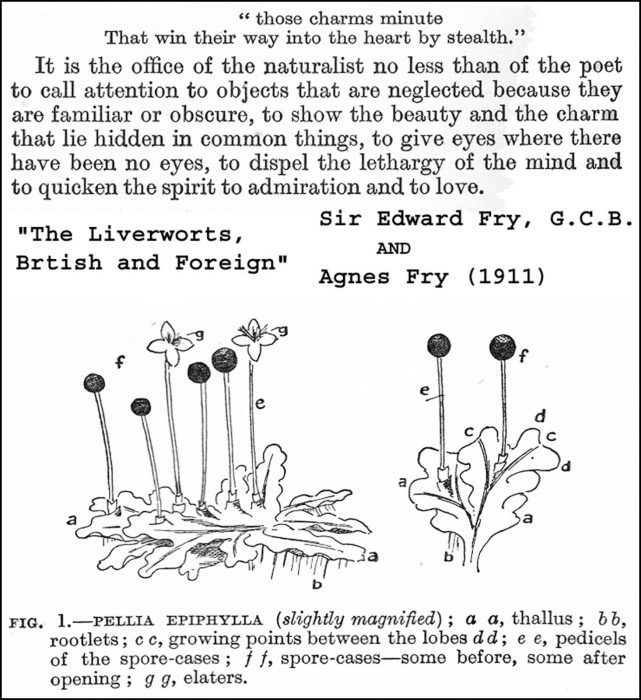
lwort
blah blh blah
]]>
Little Lookalike Legumes
Marion, Ohio
There are several clovers and clover relatives that have small heads of yellow flowers. These are members of the pea or legume family, Fabaceae, that have individually small flowers arranged in heads (or umbels that look like heads because the flower stalks are very short). The leaves are trifoliolate, i.,e, each leaf is fully and completely divided into separate leaflets. The leaflets are often mistakenly referred to as leaves, hence the proverbial “4-leaved clover” is actually a 4-leafleted clover!

Two small members of the pea family
OSU-Marion June 6, 2008
Plant genera with similar flowers are often differentiated by their fruits. Clovers in the strict sense, i.e., members of the genus Trifolium, have flowers that retain their petals into the fruiting stage, surrounding the small legumes. This is evident in the fruiting heads of a large clovers such white clover, Trifolium repens.

White clover in early fruit stage
OSU at Marion, OH, June 6, 2008
Only one of the lookalike legumes shown above is a true clover in the genus Trifolium. On the left, it’s the smaller species with fewer flowers, one of the hop-clovers, T. dubium. They’re called hop-clovers because, when in fruit, they resemble clusters of hops,the beer-flavoring agent.

Little hop-clover (Trifolium dubium) OSU at Marion, June 6, 2008
It’s interesting to note that although clovers are widespread and familiar, there’s only one native clover in Ohio (the extremely rare buffalo clover, T. stoloniferum). Here is a list of Ohio clovers from the spreadsheet generously provided by the Ohio EPA as part of their “Floristic Quality Assessment Index (FQAI) for Vascular Plants and Mosses for the State of Ohio,” by Barbara Andreas, John Mack and James McCormac, 2004, Ohio Environmental Protection Agency. Names in UPPER CASE are introduced species.
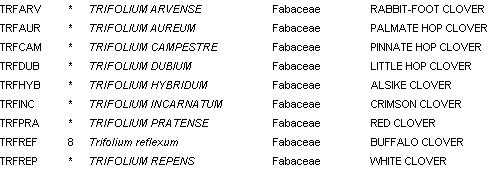
Clovers of Ohio, all but one are aliens!
On the right in the picture at the top of this post is a little yellow clover-like thing that isn’t a clover at all. It’s black medick, Medicago lupulina. In Medicago, the petals fall off after flowering and the little legumes are thus directly visible. They eventually turn black, which I guess is why a yellow-flowered plant is called black medick.

Black medick (Medicago lupulina)
OSU-Marion, June 6, 2008
Perhaps surprisingly, because it has purple flowers and looks so different, Ohio’s other Medicago is alfalfa, M. sativa.
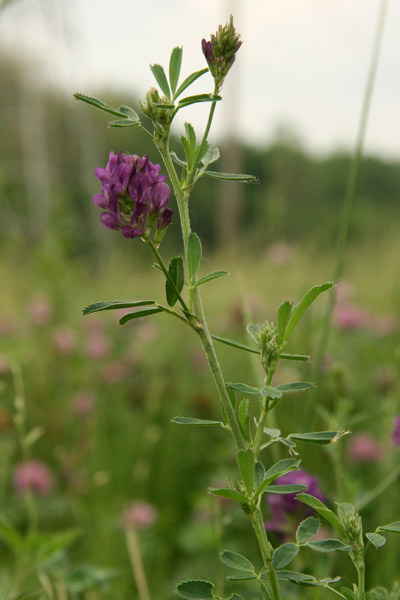
Alfalfa in Delaware County
June 7, 2008
]]>
(Excellent Columbus Dispatch article on invasive plant research)
June 3, 2008
Today’s Columbus Dispatch has a terrific article by Spencer Hunt focusing on a study by the U.S. Forest Service and OSU Plant Ecologists. The heart of the problem is the emerald ash ash borer that has caused the deaths of ash trees in the midwest. The tree loss creates sunny patches that might help invasive plants in a sort of “chain reaction” of vegetation disruption. The researchers are studying these effects at 155 research plots in Ohio and Michigan. The article has some very good pictures by Tom Baker of the Dispatch, but unfortunately they had to be rather small in order to fit into the narrow newspaper columns. Here from my photo archives are the three invasive species profiled in the article. The italicized captions are direct quotations from the profiles (Spencer Hunt, “Invasive Meltdown,” Columbus Dispatch, June 3, 2006, page A7).

Japanese honeysuckle (Lonicera japonica).
(August 30, 2003, Stages Pond State Nature Preserve, Pickaway County, OH).
“A vine that can grow when native plants are dormant; smothers most native plants in its path”

Autumn olive (Eleagnus umbellata) (May 5, 2006, along Rte 315, Delaware, OH)
“Brought to the U.S. from Asia in the 1830s; grows quickly and can trap nitrogen that other plants need.”
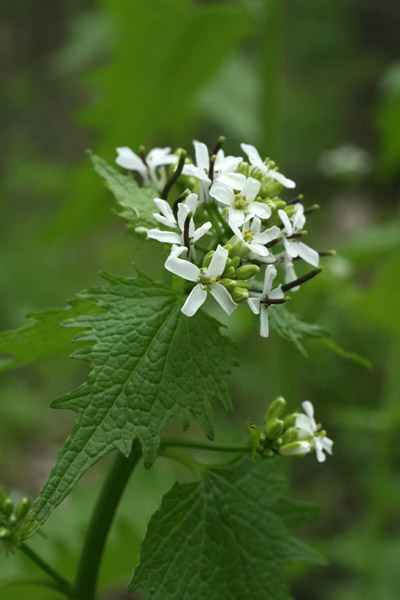
Garlic mustard (Alliaria petiolata)
(May 6, 2008, Pleasant Township Park, Marion County, OH)
“Brought to America by European settlers; produces many seeds and crowds out native plants.”
The fear is that the invasive plants will eliminate shade-tolerant native species. The four native plants that are mentioned as being vulnerable are wild geranium, wild ginger, Virginia creeper, and sensitive fern.
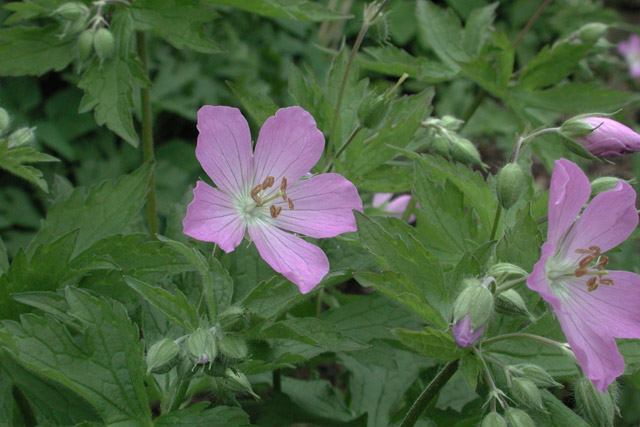
Wild geranium (Geranium maculatum)
(May 3, 2003, Terradise Nature Preserve, Marion County, OH).
This species has a ballistic seed dispersal mechanism wherein the fruits, when dry and mature, split lengthwise abruptly and fling the seeds away from the parent plant
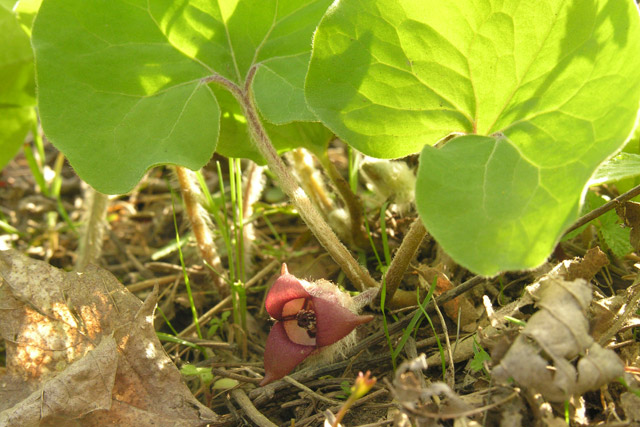
Wild ginger (Asarum canadense)
(May 5, 2005, Delaware Wildlife Area, Marion County, OH)
Not related to the ginger spice of commerce, but very similar in fragrance.
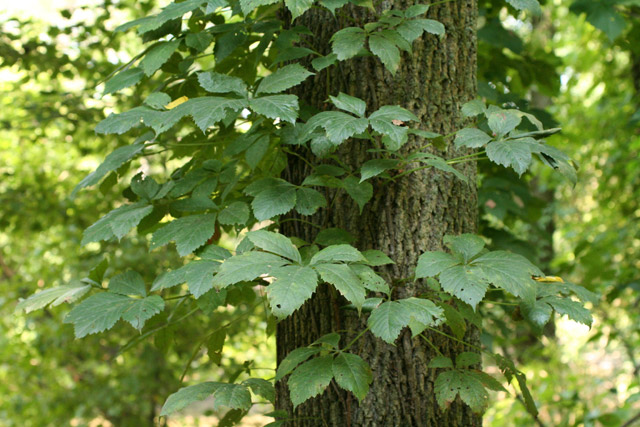
Virginia creeper (Parthenocissus quinquefolia)
(September 8, 2005, Caledonia Nature Preserve, Marion County, OH)
Often growing alongside poison ivy, distinguishable from it by having five leaflets instead of poison ivy’s three leaflets.
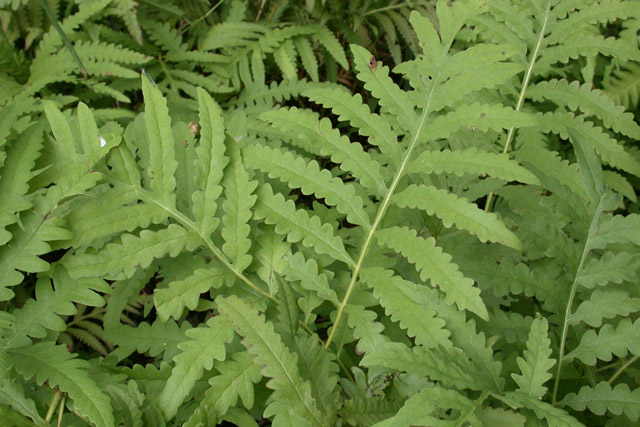
Sensitive fern (Onoclea sensibilis).
(August 31, 2004, Stages Pond State Nature Preserve, Pickaway County, OH)
Named for its sensitivity to frost.
The “chain reaction” that the ecologists are worried about is the detrimental effects that could cascade down to the organisms (microbes, insects and other animals) that are associated with the native plants. This is both a serious problem and an intriguing area for research. Another great piece of science reporting by our local paper, much appreciated!
]]>June 2, 2008
There are 11 species of rose growing wild in Ohio, of which five are native, six are alien. There is a rose shrub flowering profusely at the edge of the woods at OSU’s outdoor plant research area, Waterman Lab, which is familiarly called “Waterman Farm.” A few days ago it seemed the petals of this rose were more rose-colored than they are today; now they are almost white. It turns out to be one of the introduced (escaped from cultivation) ones, Rosa canina, “dog rose.” How can you tell?
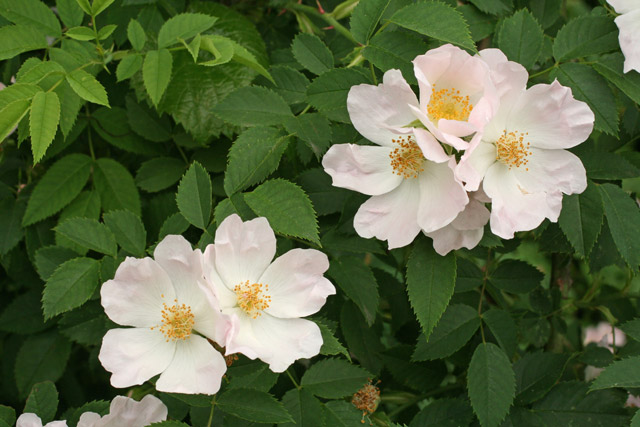
Dog rose (Rosa canina),
Waterman Farm, Columbus OH, June 2, 2008.
One of the features that sets apart groups of roses has to do with the group of styles that emerges from the mouth of the floral cup (hypanthium). In some species (not this one) the styles extend out above the mouth for some distance as an elevated projection, whereas in the group to which dog rose belongs, the styles stop abruptly just above the mouth.
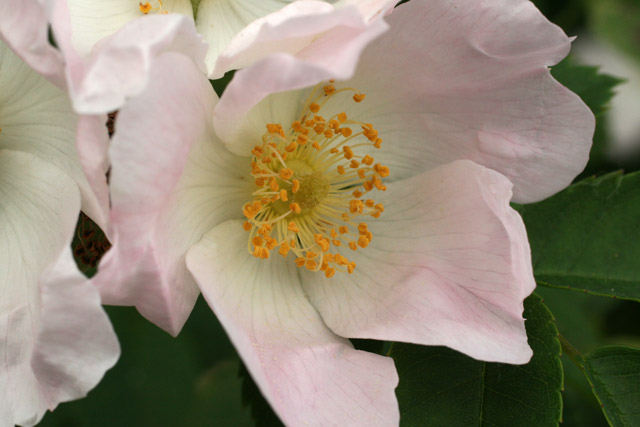
Dog rose (Rosa canina)
Waterman Farm, Columbus, OH, June 2, 2008.
A feature of the calyx (sepals, considered collectively) is important too. In some species (not this one), all the sepals are more or less the same, whereas in the group that dog rose belongs to, the outermost sepals have narrow leaf-like side extensions.
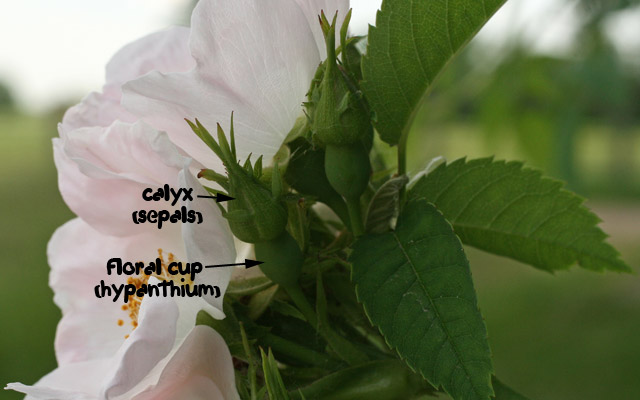
Dog rose (Rosa canina)
Waterman Farm, Columbus, OH, June 2, 2008.
Rose leaves are pinnately compound and have prominent persistent stipules at the base of the leafstalk. The stipules are of diagnostic value, as in some species (not this one) they are hairy or have frilly edges. Dog rose stipules are smooth-edged and hairless, and attached to the leafstalk for most of their length.
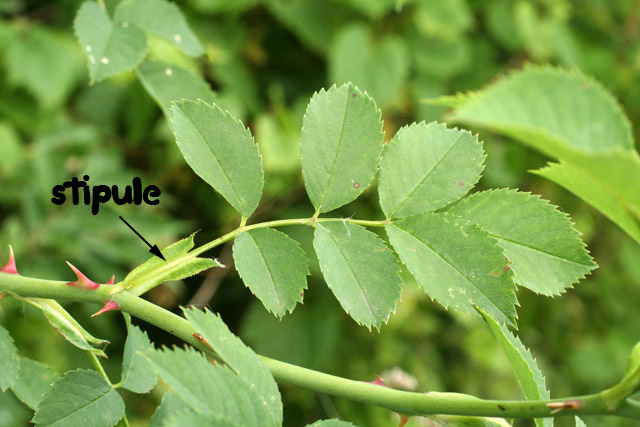
Rosa canina leaf
June 2, 2008, Waterman Farm, Columbus, OH.
This bug (it really is a “bug,” because entomologists use that word in a scientific way in reference to any member of the order Hemiptera) is a stinkbug. Stinkbugs are called that because they give off a bad smell if they are crushed or handled roughly. Is this one a plant-eating stinkbug or a predatory stinkbug that is waiting there to attack a pollinating insect?
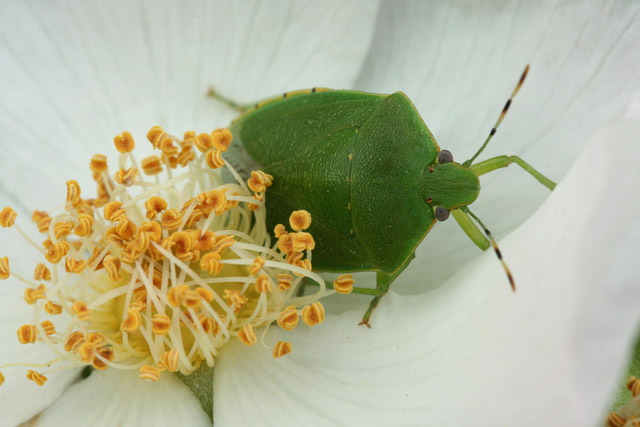
Stinkbug (Order Hemiptera, family Pentatomidae) on dog rose
Waterman Farm, June 2, 2008.
The Apiaceae is a very distinctive plant family. It is named after the genus Apium, which includes celery, A. graveolens. The Apiaceae used to be called the “Umbelliferae,” meaning “umbel-bearing,” because the flowers are usually borne in distinctive radiating clusters called umbels within which the flowers are individually stalked and attached all at the same point on the flowering stem. Queen-Anne’s lace and poison hemlock are familiar wild examples, while dill-weed, carrot and parsley are found in the garden. Other distinguishing Apiaceae traits are compound leaves with a base that sheaths the stem, and tiny flowers that have an inferior ovary that develops into a unique fruit type called a “schizocarp” that separates into two individual one-seeded units. Some familiar spices –dill “seed,” and caraway “seed” –are from this family. (Being a portion of fruit containing a seed, these spices technically are not seeds, although in nature they function as such.)
Nowadays, all plant families name start with the prominent genus in that family and end in “-aceae” (pronounded “ai-seh-ee”). Older books, however, designated a few families by names that don’t have “-aceae” endings. There are 8 of them, mostly very large families with some singular distinctive trait. People (old people, anyhow) still refer to “crucifers” in reference to the traditional name of the mustard family, Cruciferae (nowadays called Brassicaceae), and “composites” for the aster family, Asteraceae.
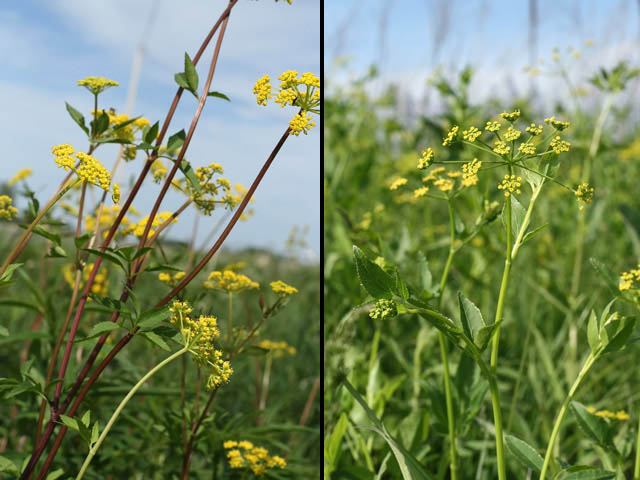
Claridon Railroad Prairie
Marion County, OH, May 29, 2008
Claridon Railroad Prairie is a diverse prairie remnant of the Sandusky Plains. The prairie is one mile long and 50 feet wide, situated between an active CSX railroad track and a little-used county Road in Marion County, OH. It was the inspiration and primary seed source for the Larry R. Yoder Prairie, a prairie restoration at OSU’s Marion Campus. Both similar umbelliferous species occur at Claridon, and they are flowering now.
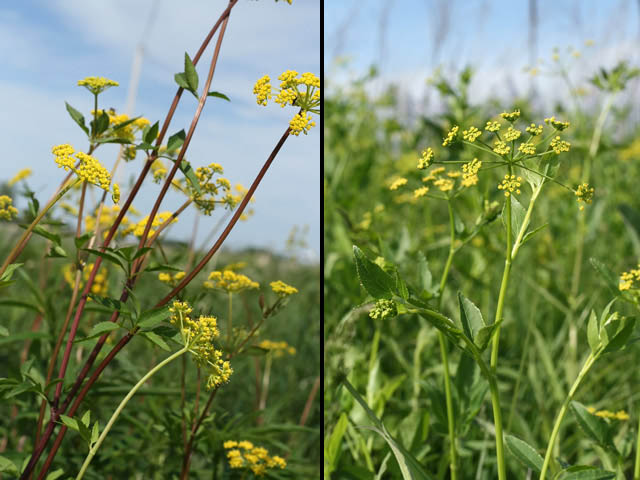
Two simlar umbellifers
Left: golden Alexanders (Zizia aurea), Right: meadow parsnip (Thaspium trifoliatum)
Claridon Railroad Prairie, Marion County, OH, May 29, 2008

Leaves of two simlar umbellifers
Left: golden Alexanders (Zizia aurea), Right: meadow parsnip (Thaspium trifoliatum)
Claridon Railroad Prairie, Marion County, OH, May 29, 2008
In a standard botanical reference manual, the genera Zizia and Thaspium end up alongside ea ch other, separated by details of the inflorescence and the ovary. (Note that the Zizia leaf specimen above has five leaflets although it’s supposed to have only three. Evidently the plant didn’t read the book.)

Both diagnostic traits can be discerned when the plants are either flowering or fruiting, although the ovary-is-winged feature, subtle in flower, is very conspicuous in fruit. The central flower, and only the central flower, of Zizia is sessile (stalkless), while all the flowers of Thaspium are stalked. Note also the prominently winged ovary (lower portion of epigynous flowers such as these) is winged in the Thaspium.

Partly dissected umbellets of two similar yellow-flowered prairie umbellifers
Zizia is on the left and Thaspium is on the right.
A few flowers were cut off from the foreground region of each cluster to reveal the central flowers.
Claridon Prairie, May 30, 2008
There’s a massive display of white blue-eyed grass at the west end of the prairie. This species, Sisyrinchium albidum (family Iridaceae) was noted two weeks ago at the Marion Campus Prairie, where only one plant was seen and it had a distinct bluish cast to the flowers. Flower color can vary, and albino forms of many plants that are normally pink or blue-flowered occur now and then. This raised the question, “Are you sure this is white blue-eyed grass and not just a nearly albino form of a more common species?” (S. angustifolium is the common Ohio species of blue-eyed grass.) Generally when similar species differ by flower color, there are other differences as well, and that’s true in this case: E. Lucy Braun in Monocots of Ohio tell us that S. albidum spathes (paired leaf-like appendages from which the flowers arise) are stalkless, whereas the spathes of S. angustifolium are stalked. She also mentions that the flowers of S. albidum, which are normally white, can also be blue. That would be “blue white blue-eyed grass”!

Sisyrinchium albidum (family Iridaceae), Claridon Railroad Prairie, Marion County, OH, May 30, 2008.
The fleabanes (genus Erigeron in the family Asteraceae) are native annuals, biennials or short-lived perennials. They resemble asters (Symphyotrichum) but are generally spring-flowering whereas the asters bloom in late summer and fall. I’m not sure of the species, but I think that the one with clasping leaves, which this seems to have, is the Philadelphia fleabane, Erigeron philadelphicus.
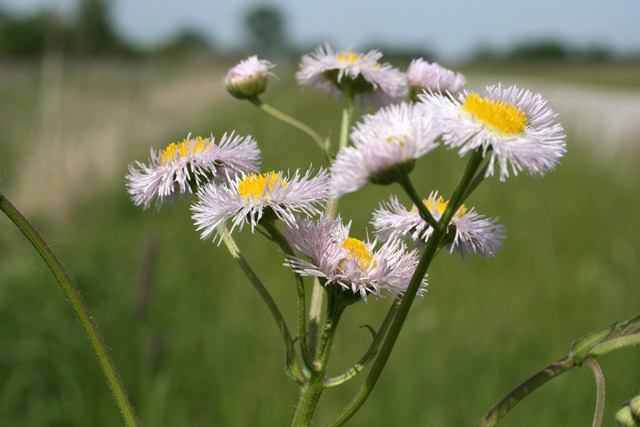
Erigeron philadelphicus at Claridon, May 29, 2008
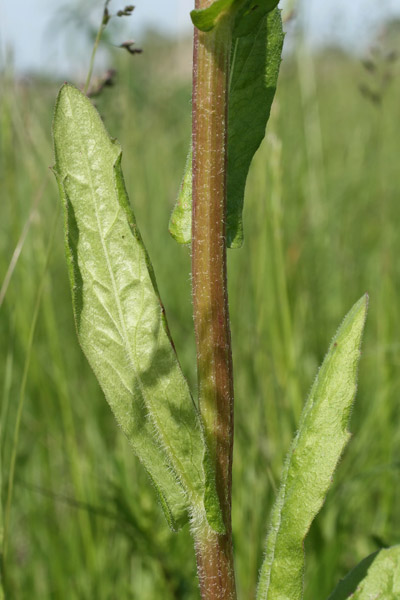
Erigeron philadelphicus leaves
May 29, 2008.
Last week I saw a striking display of a native perennial prairie herb, golden ragwort (Senecio aureus) at the Larry R. Yoder Prairie on the OSU at Marion Campus. Of similar aspect but strikingly different ecology, there’s a comparatively new weedy Senecio, S. glabellus, here in central Ohio. It’s called “butterweed,” and it’s unusual among aliens in that, unlike most of our weeds which originated in faraway other continents like Europe, Asia or Altantis, this one is native to southeastern states of the good old U. S. of A! (A few other North American weeds occur in Ohio, but most of them, such as wild 4-o-clock (Myrabilis nyctaginea) and western mugwort (Artemisia ludoviciana) are dry-site western species that spring up along railroad tracks, no doubt brought there by the trains.)

Butterweed (Senecio glabellus, family Asteraceae)
OSU-Marion, May 29, 2008.
Presently this species is blanketing many first-year fallow corn or bean fields throughout the region, forming massive swathes of golden yellow. It seems to be a relative newcomer here. Neither I nor several plant-oriented people I’ve spoken with about it recall having seen butterweed until about a decade ago, and they agree it seems more and more prevalent every year.

Butterweed (Senecio glabellus, family Asteraceae)
OSU-Marion, May 29, 2008.
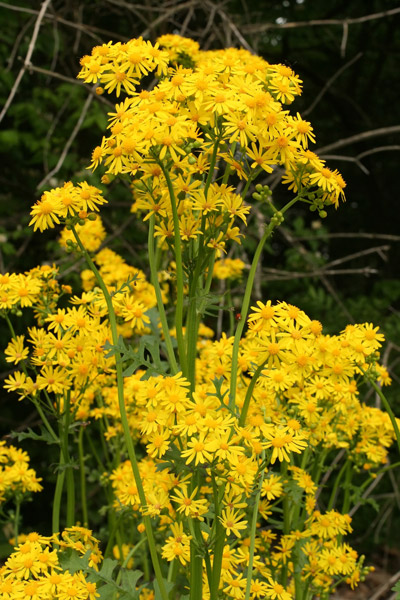
Butterweed (Senecio glabellus, family Asteraceae)
OSU-Marion, May 29, 2008.

Portion of stem of butterweed (Senecio glabellus, family Asteraceae)
OSU-Marion, May 29, 2008.
Portion of stem of butterweed (Senecio glabellus, family Asteraceae) at OSU-Marion, May 29, 2008. The stems are glabrous (hairless) and the leaves are deeply lobed.

Flower heads of butterweed (Senecio glabellus, family Asteraceae)
OSU-Marion, May 29, 2008.
Flower heads of butterweed (Senecio glabellus, family Asteraceae) at OSU-Marion, May 29, 2008.
]]>While the bio students caught insects for the “animal diversity” lab, the instructor re-visited a spot where bastard-toadflax recently appeared in great profusion. Now more of the plants are flowering.
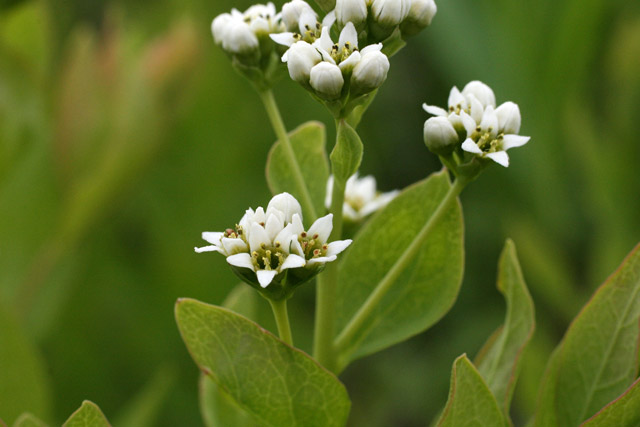
Bastard-toadflax (Commandra umbellata)
May 23, 2008, OSU-Marion
Golden ragwort (Senecio aureus, family Asteraceae) is a native perennial herb of prairies and open woods.
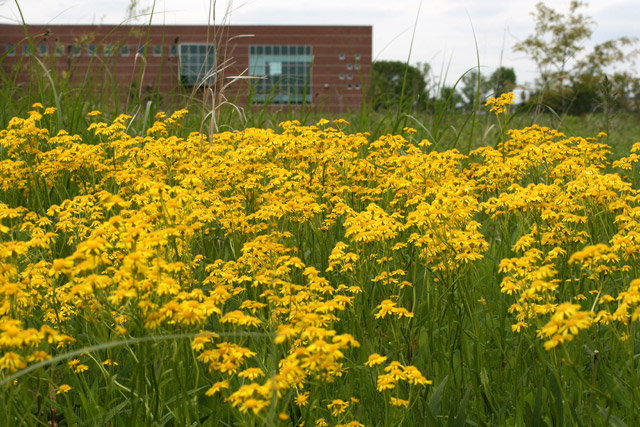
Golden ragwort, Senecio aureus at OSU-Marion
May 23, 2008
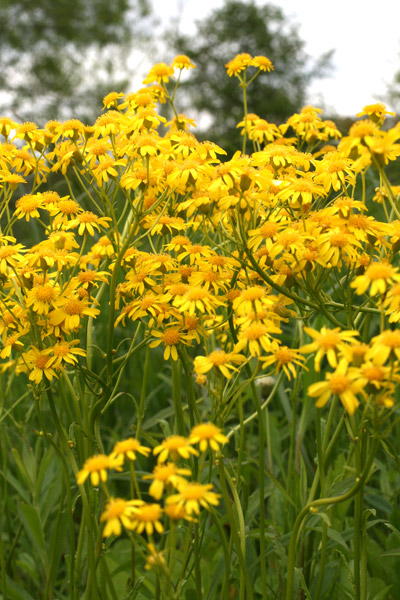
Golden ragwort, Senecio aureus at OSU-Marion
May 23, 2008
Greenlawn Cemetery
Greenlawn Cemetery in Columbus, Ohio is a beautiful and historic cemetery that is well known as a great place for birding and seeing a variety of trees. I was there this morning with my Human Biology class, doing a lab activity called “Cemetery Demography” that constructs life tables based on birth and death dates for people born in the 1830’s versus those born in the 1880’s. While the students were recording data, I snapped some pics of plants. The tulip-trees (Liriodendron tulipifera, family Magnoliaceae) are in full flower.
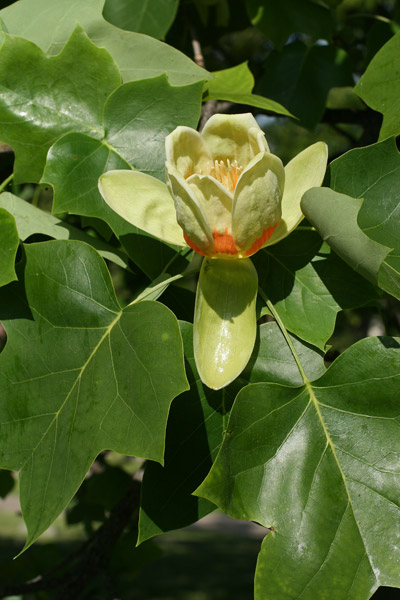
Liriodendron tulipifera
Greenlawn Cemetery, May 23, 2008
The flowers of Liriodendron are much like those of Magnolia, and are generally regarded, along with buttercups (family Ranunculaceae) and water-lilies (Nymphaceae), to be among the most primitive flowers. This can be conceptualized by recognizing that flowers are basically modified branches and that flower parts –sepals, petals, stamens, and pistils –are modified leaves on those branches. The flowers that most resemble a branch with leaves are regarded as most primitive. The made-up word “FENSH” is a guide to the features of primitive flowers.
“F” signifies “FREE,” as the flower parts are separate (free) from one another, i.e., they are not fused.
“E” stands for “EQUAL,” as the flower parts within a series are the same size and shape. i.e., the flowers are radially symmetric.
“N” means the flower parts (not the flowers themselves) are NUMEROUS.
“S” is for “SPIRAL,” as the numerous flower parts are spirally arranged.
“H” represents the HYPOGYNOUS nature of the first flowers, wherein the petals, sepals, and stamens rise away from the flower below the pistils. (This is also called having a “superior ovary.”)
Notice in the tulip-tree blossom. how the flower parts are separate, all the petals are the same size, the stamens are numerous and spirally arranged, and the pistils (which are also numerous and spirally aranged) are the topmost features. A FENSH flower, primitive.
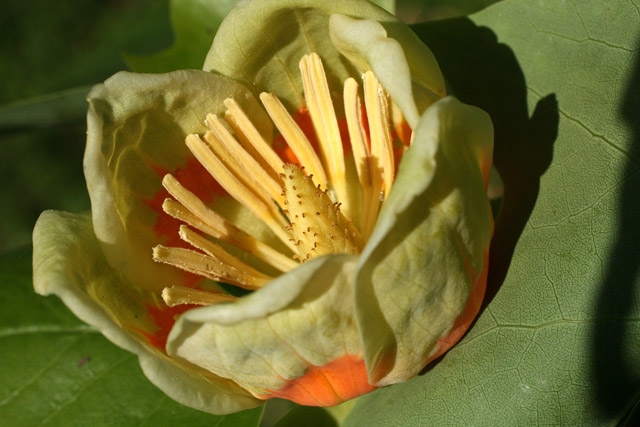
Tulip-tree flower
Greenlawn Cemetery, May 23, 2008
Covering a large stump sawed-off level with the ground and also scattered in the lawn nearby is an “inky cap” mushroom, in the genus Coprinus, maybe C. atramentareus. The inky caps have closely spaced narrow black gills that decompose into black liquid as (or perhaps after) they mature.
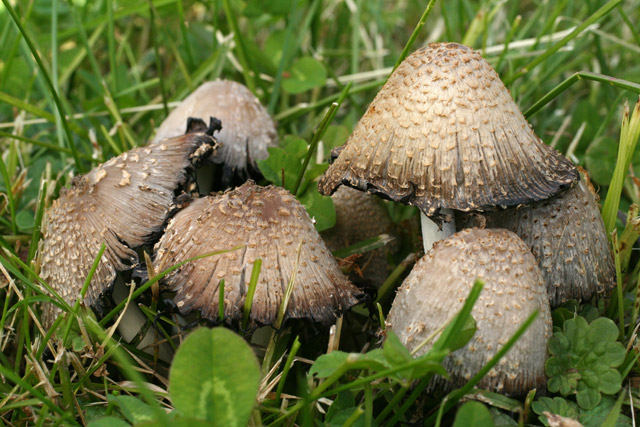
Inky-caps (genus Coprinus) at Greenlawn Cemetery, May 23, 2008.
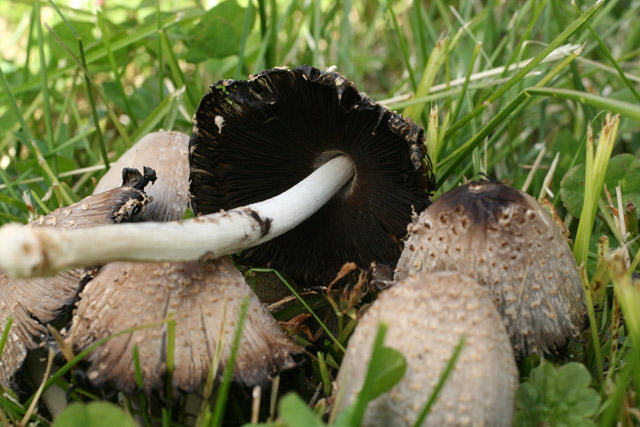
Inky-cap (genus Coprinus) have closely spaced narrow gills.
Greenlawn Cemetery, May 23, 2008, Columbus, OH
Before they go “inky,” the inky caps are edible, but some, such as this one, have an unususal side-effect. When consumed with alcohol, the result is intense nausea. This is caused by a chemical in the mushrooms related to the pharmaceutical medicine “antabuse,” used to treat alcohol dependency.
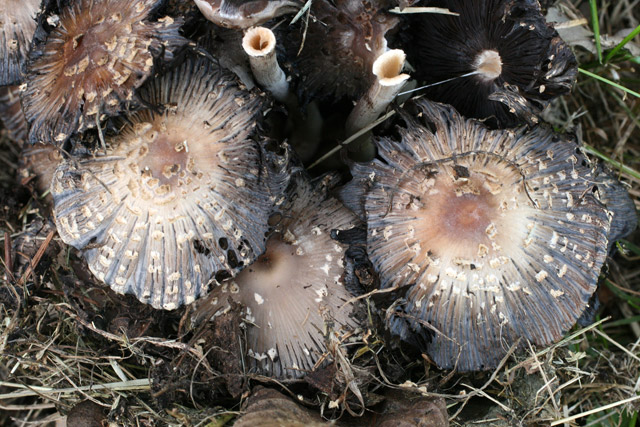
Inky-cap (genus Coprinus) gills at Greenlawn Cemetery, Columbus, OH
Douglas-fir (Pseudotsuga menziesii) is a magnificent forest tree of the Pacific northwest that rivals redwoods in height but is much more abundant. The familiar smell of plywood is the smell of “Doug-fir.” This is a member of the Pine family (Pinaceae) that can be a little hard to identify as its single (not clustered as in pines and larch) needles make it resemble a true fir (genus Abies) or a spruce (genus Picea). There are subtle differences in the leaves and twigs, but when they have cones, identification is super-easy. Douglas-fir cones have their papery bracts that are located above each woody cone scale extending far out from the scale. (In almost all other pine family members the bracts are shorter than the scales, hence they are not visible unless the cones are dissected.)

Douglas-fir with old seed cones
May 23, 2008, Greenlawn Cemetery, Columbus OH
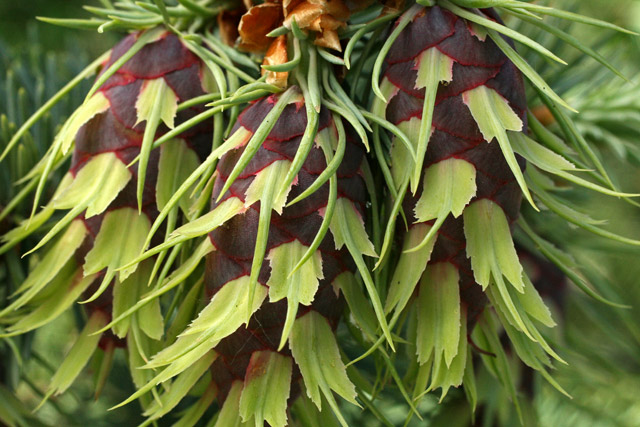
Douglas-fir young seed cones, May 23, 2008
Greenlawn Cemetery, Columbus, OH.
In Columbus (and elsewhere no doubt) a few small native woodland wildflowers have established themselves as lawn weeds. Spring-beauty, (Claytonia virginiana, family Montiaceae) is a good example. Several species of violets too grace lawns in some places. Here at Greenlawn, the striped creamy violet, Viola striata (family Violaceae) is especially abundant.
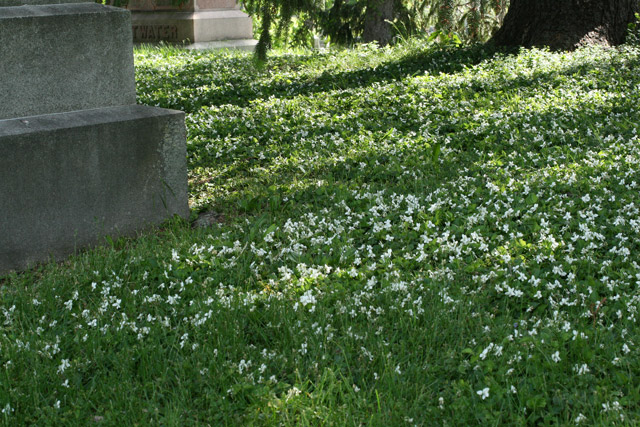
Viola striata patch in green lawn at Greenlawn Cemetery, May 23, 2008
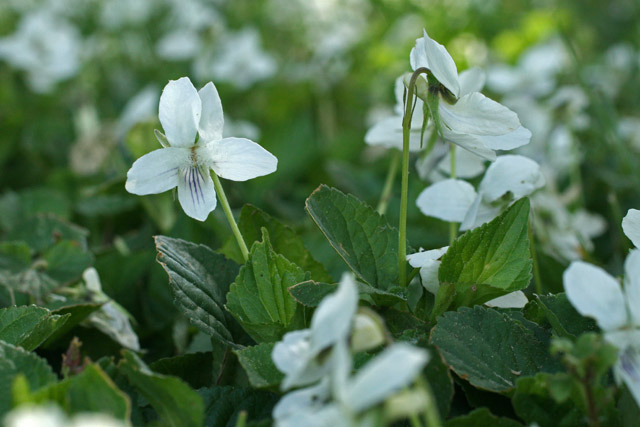
Viola striata, Greenlawn Cemetery, Columbus, OH May 23, 2008
]]>